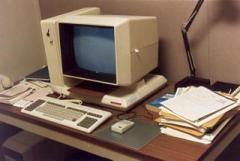Apollo Computer: Difference between revisions
→External links: dead link |
"inspired" is more accurate |
||
| (One intermediate revision by the same user not shown) | |||
| Line 12: | Line 12: | ||
Apollo was acquired by [[Hewlett-Packard]] in 1989 for US $476 million, and gradually closed down over the period 1990-1997. But after acquiring Apollo Computer in 1989, HP integrated a lot of Apollo technology into their own [[HP 9000]] series of workstations and servers. The Apollo engineering centre took over PA-RISC workstation development and Apollo became an HP workstation brand name (''HP Apollo 9000'') for a while. |
Apollo was acquired by [[Hewlett-Packard]] in 1989 for US $476 million, and gradually closed down over the period 1990-1997. But after acquiring Apollo Computer in 1989, HP integrated a lot of Apollo technology into their own [[HP 9000]] series of workstations and servers. The Apollo engineering centre took over PA-RISC workstation development and Apollo became an HP workstation brand name (''HP Apollo 9000'') for a while. |
||
Apollo also invented the [[revision control]] system ''DSEE'' ([[Apollo Domain|Domain]] Software Engineering Environment) which |
Apollo also invented the [[revision control]] system ''DSEE'' ([[Apollo Domain|Domain]] Software Engineering Environment) which inspired [[IBM Rational ClearCase]]. DSEE is pronounced dizzy. |
||
== Company history == |
== Company history == |
||
Revision as of 14:47, 4 August 2008
Apollo Computer, Inc., founded 1980 in Chelmsford, Massachusetts by William Poduska (a founder of Prime Computer), developed and produced Apollo/Domain workstations in the 1980s. Along with Symbolics and Sun Microsystems, Apollo was one of the first vendors of graphical workstations in the 1980s.

In 1981, the company unveiled the DN100 workstation, which used the Motorola 68000 microprocessor. Apollo workstations ran Aegis (later renamed Domain/OS), a proprietary operating system with a POSIX-compliant Unix alternative frontend. Apollo's networking was particularly elegant, among the first to allow demand paging over the network, and allowing a degree of network transparency and low sysadmin-to-machine ratio.
From 1980 to 1987, Apollo was the largest manufacturer of network workstations. At the end of 1987, it was third in market share after Digital Equipment Corporation and Sun Microsystems, but ahead of Hewlett-Packard and IBM. Apollo's largest customers were Mentor Graphics (electronic design), General Motors, Ford, Chrysler, Chicago Research and Trading (Options and Futures) and Boeing (mechanical design).
Apollo was acquired by Hewlett-Packard in 1989 for US $476 million, and gradually closed down over the period 1990-1997. But after acquiring Apollo Computer in 1989, HP integrated a lot of Apollo technology into their own HP 9000 series of workstations and servers. The Apollo engineering centre took over PA-RISC workstation development and Apollo became an HP workstation brand name (HP Apollo 9000) for a while.
Apollo also invented the revision control system DSEE (Domain Software Engineering Environment) which inspired IBM Rational ClearCase. DSEE is pronounced dizzy.
Company history
Despite beginning two years earlier than Sun Microsystems, Apollo did not maintain the lead that should have been afforded by that two-year advantage. In hindsight, this is easily attributable to the maintenance of a proprietary operating system as the industry was moving toward Unix standardization. The Aegis/Domain operating system, while always supporting Unix-like commands, was not incorporated with or replaced by Unix until about 1987, when Domain version 10 introduced Unix API support and Unix-style memory management. Domain/OS was originally written in a proprietary version of Pascal and was not built on a Unix kernel. Version 10 was built on Unix but the burden of backwards compatibility with previous releases led to a system that was larger and significantly slower than the previous ones. Apollo was reluctant to abandon its customers in future releases, although with hindsight it's clear that had they done so they may have been able to recover their market share. In the end, Hewlett Packard shut down the Domain/OS line. Release 10 came out as competitors were gaining ground in the area of graphics and windowing systems, particularly with the trend to Open Systems and the X Window System.
Another feature or glitch was their proprietary token-ring network, which was originally designed to support relatively small networks of, at most, dozens of computers in an office environment. Theoretically it was a superb design, but it did not interoperate with any other existing network hardware or software. It was left behind when the industry widely adopted Ethernet and TCP/IP. Apollo later added support for these industry standards but never allowed as much interoperability as its competitors.
In the hardware area, Apollo's vertical structure, producing much of its own hardware and software, made innovation slow and expensive compared to Sun, which purchased components from the open market. The company was also involved in two technological transitions. It decided to abandon its proprietary data bus architecture in favor of IBM's AT-bus, as used in the second generation of IBM PCs, and was simultaneously embracing RISC technology moving towards high-end processors, eventually producing the PRISM line.
The workstation industry in general experienced hard times in the second half of the 1980s, as IBM Personal Computers and IBM PC compatibles began making inroads on their customer base. Apollo was entering a financial squeeze. The company's management style changed in 1985 with the hiring of Thomas Vanderslice as President and CEO.
In 1987 the company incurred large losses in currency speculation, apparently due to the trading activities of one individual.[1] In 1989 Apollo was acquired by Hewlett-Packard.
References
- ^ Markoff, John. (July 8, 1988). "Apollo's Troubles Stun Wall St". New York Times.
See also
External links
This article was partly based on material from the Free On-line Dictionary of Computing and is used with permission under the GFDL.
